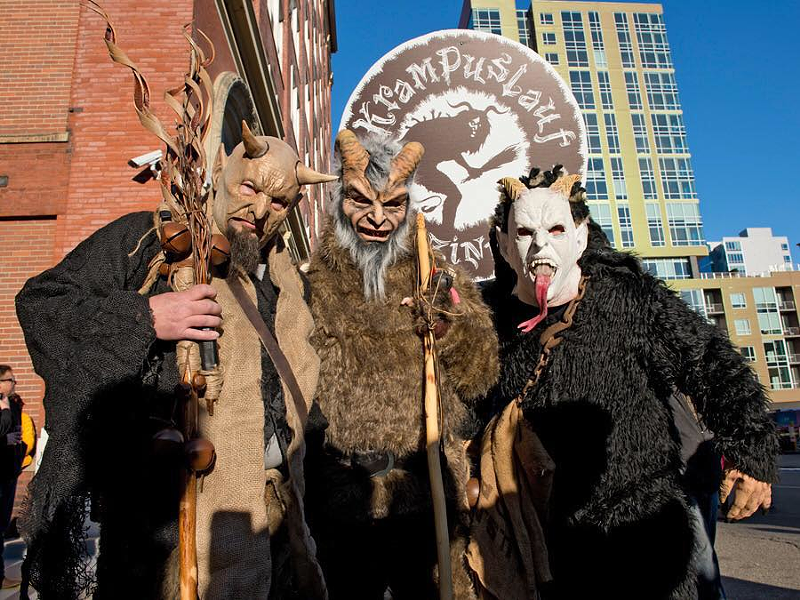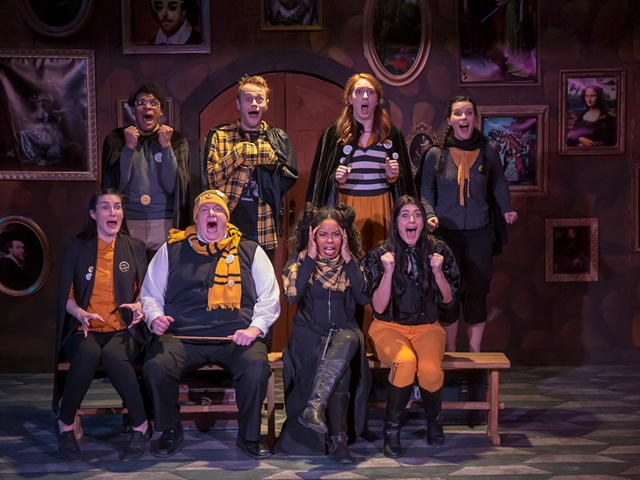If you’ve paid attention to pop culture over the past several years, chances are you’ve heard of Krampus, perhaps from the 2015 holiday horror film of the same name or perhaps you’ve avoided being stuffed into his sack while visiting one of Cincinnati’s German-themed Christmas markets.
Krampus — a sort of mythical furry, horned goat-demon — appears in holiday traditions throughout Central and Eastern Europe. Typically, he walks the streets on Dec. 5 during Krampusnacht (or Krampus Night, an evening of debaucherous revelry) and on Dec. 6 for Saint Nicholas Day, when the bearded saint arrives bearing gifts.
“While Sankt Nikolaus (German for Saint Nicholas) brings good children candy and treats, legend states that Krampus punishes bad children during the yule season and captures particularly naughty children and carries them away to the woods,” says Brother James, co-founder of Krampuslauf Zinzinnati.
James refers to Krampus as the “other side of (the Saint Nicholas) coin” — the sort of yin to his yang, the dark to his light.
"Krampus is an amalgamation of several different figures from Central European folklore that were, over time, merged into the mythical figure of Krampus. By the 17th century, this creature was incorporated into the Christian tradition of Sankt Nikolaus and became his partner," James says.
And since 2014, the Christmas beast has been appearing at various Queen City events thanks to Krampuslauf Zinzinnati.
Inspired by groups found throughout Europe and the U.S. (e.g. Krampuslauf Philadelphia, Krampus Lauf PDX, Baltimore Krampuslauf), James and three friends — David Dalton, Geof Garver, and David Plogman — made Krampus (pronounced “krohm poo s” vs. “kram-pu s” they say) come alive. And three to five times per year around the holidays, costumed Krampuses will descend upon events via invite to spread knowledge of the winter tradition and take photos with people to raise money for charity.
We chatted with James via email to learn more about his group, the story of Krampus and to reverse some common misconceptions about the anthropomorphic fiend.
CityBeat: How many current Krampuses do you have on board?
Brother James: About eight or nine at last count. But we also have someone dressed as Sankt Nikolaus, as well as several "handlers." The handlers are important as it's hard for the Krampuses to communicate while wearing their masks, and the handlers help with that, as well as help organize any picture taking and donation collection.
CB: And what do you guys do at the events?
BJ: Our group walks around the event — usually several Krampuses, as well as one person dressed as Sankt Nikolaus — and people come to us wanting to take pictures with our group, or often just to greet us and thank us for coming. We raise money for Boys & Girls Clubs of Greater Cincinnati by asking folks to donate something if they take a picture with us or to donate just because. Almost everyone contributes something and we've raised a lot money — each year getting better than the last.
CB: Where do you get your costumes?
BJ: All the costumes are handmade by our members. Usually they are different parts of other costumes/masks that have been modified, or they're built from scratch.
CB: Are there different variations of the Krampus costume?
BJ: Each Krampus in our group has a costume that is their own interpretation of the character. Our members have spent a ton of time researching traditional depictions of Krampus in German and Austrian culture, as well as researched what others have done to make their costumes, both in the U.S. and Europe.
CB: What accessories do you carry?
BJ: Krampus usually carries a bundle of sticks, or ruten in German, as that's the traditional gift for the naughty children instead of candy or treats. Krampus often carries a whip or a cat o' nine tails to "beat" bad children with — though we never do so. However, some adults often insist that a mock beating (of the adult) be part of their Krampus photos. Krampuses usually have chains hanging from them, and a common, traditional accessory is a very large, loud cow bell, or several.
CB: What's the most common misconception about Krampus?
BJ: That Krampus is evil and/or we are at events to scare children.
CB: What do you want to make sure people know about Krampus and your organization?
BJ: We are at events by invitation, we do not appear where we have not been welcomed by event organizers. We are not at events to scare children — in fact, children are our biggest fans. We are helping to keep a beloved German tradition alive and educate the public about this tradition and its roots. Most of all, we're there to have fun and so that others can have fun with us.
CB: Best reaction?
BJ: At every event we have countless children that approach us wide-eyed or excited to meet/visit with Krampus. It's a real treat to see their reactions, and I know it warms all of our hearts to interact with them.
CB: Worst reaction?
BJ: We've had many adults that don't know anything about the history or tradition, don't bother to let us explain — we pass out pamphlets that provide a lot of history and information — and accuse us of scaring children and making up something new because we "hate Christmas." All of that could not be further from the truth.
Krampuslauf Zinzinnati will be at Streetside Brewery (4003 Eastern Ave., Columbia Tusculum) from 6-9 p.m. Friday, Dec. 6; at the Krampus-themed Covington Winter Night Bazaar 7 p.m.-midnight Saturday, Dec. 7; and at West Side Brewing (3044 Harrison Ave., Westwood) on Saturday, Dec. 14 for a Krampus Kandy beer release and photos. Get more info at facebook.com/cincykrampus.
*Brother James has asked we use this moniker as his full name






